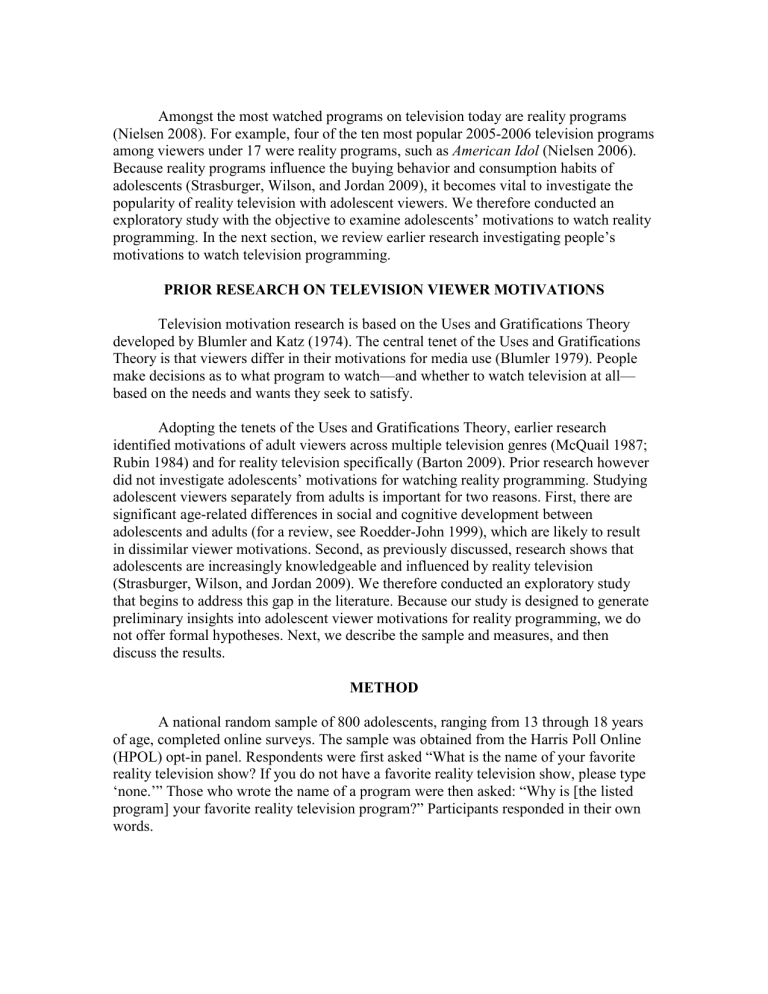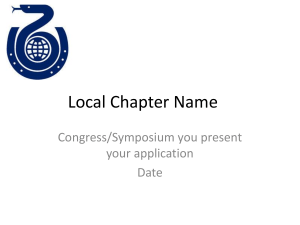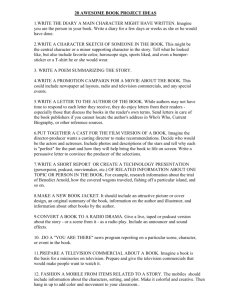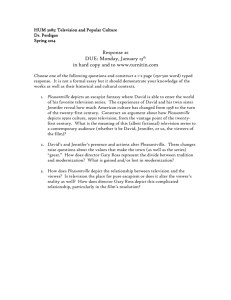The television programming landscape has changed dramatically

Amongst the most watched programs on television today are reality programs
(Nielsen 2008). For example, four of the ten most popular 2005-2006 television programs among viewers under 17 were reality programs, such as American Idol (Nielsen 2006).
Because reality programs influence the buying behavior and consumption habits of adolescents (Strasburger, Wilson, and Jordan 2009), it becomes vital to investigate the popularity of reality television with adolescent viewers. We therefore conducted an exploratory study with the objective to examine adolescents’ motivations to watch reality programming. In the next section, we review earlier research investigating people’s motivations to watch television programming.
PRIOR RESEARCH ON TELEVISION VIEWER MOTIVATIONS
Television motivation research is based on the Uses and Gratifications Theory developed by Blumler and Katz (1974). The central tenet of the Uses and Gratifications
Theory is that viewers differ in their motivations for media use (Blumler 1979). People make decisions as to what program to watch—and whether to watch television at all— based on the needs and wants they seek to satisfy.
Adopting the tenets of the Uses and Gratifications Theory, earlier research identified motivations of adult viewers across multiple television genres (McQuail 1987;
Rubin 1984) and for reality television specifically (Barton 2009). Prior research however did not investigate adolescents’ motivations for watching reality programming. Studying adolescent viewers separately from adults is important for two reasons. First, there are significant age-related differences in social and cognitive development between adolescents and adults (for a review, see Roedder-John 1999), which are likely to result in dissimilar viewer motivations. Second, as previously discussed, research shows that adolescents are increasingly knowledgeable and influenced by reality television
(Strasburger, Wilson, and Jordan 2009). We therefore conducted an exploratory study that begins to address this gap in the literature. Because our study is designed to generate preliminary insights into adolescent viewer motivations for reality programming, we do not offer formal hypotheses. Next, we describe the sample and measures, and then discuss the results.
METHOD
A national random sample of 800 adolescents, ranging from 13 through 18 years of age, completed online surveys. The sample was obtained from the Harris Poll Online
(HPOL) opt-in panel. Respondents were first asked “What is the name of your favorite reality television show? If you do not have a favorite reality television show, please type
‘none.’” Those who wrote the name of a program were then asked: “Why is [the listed program] your favorite reality television program?” Participants responded in their own words.
2
RESULTS
Of the 800 respondents, 339 (46.13%) did not list a favorite reality program, and
30 (3.75%) listed a favorite program that was not a reality program. These 369 respondents were not included in the analyses. Of the 431 respondents who were included in the analyses, each listed on average 1.55 motivations. We divided the sample into two age groups: younger teens (12 to 15 year olds) and older teens (16 to 18 year olds), and analyzed adolescents’ viewer motivations separately for males and females within each of the two age groups.
Two coders who were unfamiliar with the objectives of the study were asked to independently code participants’ viewer motivations. Because of the exploratory objective of this research, we refrained from imposing an a priori structure on the data by suggesting content categories (viewer motivations) to the coders. We adopted the procedure described by Kaltcheva and Weitz (2006). First, each coder independently coded the responses to determine a set of relevant content categories. Next, through discussion, the two coders established a common set of content categories, and the definitions of those categories. Then, each coder used the established common categorization scheme and independently coded all responses. The intercoder reliability, evaluated with Perreault and Leigh’s (1989) reliability index, was 86%, which is considered to be an acceptable level of inter-coder reliability (Saldana 2009). The coders resolved disagreements through discussion.
Because both the independent (four age x gender groups) and the dependent
(viewer motivation categories) variables in our study are nominal variables, the data was analyzed using correspondence analysis, which is known as “factor analysis for categorical data” (Myers and Mullet 2003, p. 305). Correspondence analysis creates a two-dimensional space. The categories of the independent and dependent variables are located in that space in such a way that categories with similar (dissimilar) distributions are close to each other (far apart) (Clausen 1998).
In our study, the two dimensions accounted for 88% of the variance. One viewer motivation—entertainment/excitement—was located in the center of the two-dimensional space, and it was approximately equidistant from all age x gender groups, suggesting that watching reality programs for entertainment is an equally important motivation for all adolescents. Other viewer motivations were differentially important across the four age x gender groups. Both male and female adolescents in the 16 to 18 age range (older teens) seek reality programs that incorporate dramatic situations and relationships among the program participants. Gender differences were found for the younger adolescents (the 13 to 15 age range). Whereas younger males prefer reality programs that involve humorous and/or inspirational elements, females of the same age watch a reality program because of one or more of the participants/characters featured in the program and the program’s realism (real people placed in real-life situations).
3
Our results are consistent with extant developmental theories which show that the appreciation of dramatic content and human relationships typically requires a higher level of cognitive and emotional sophistication, which is gradually developed throughout adolescence (Vorderer and Knobloch 2000; Zillman 2000). Our research offers insights that would be helpful to television programmers, advertisers, and public policy makers.
For example, television programmers and advertisers can utilize motivation-based segmentation when developing more targeted programming schedules and media buys with quality rationale. By understanding adolescent motivations to watch reality programming, public policy experts can appeal to the same motivations and encourage adolescents to engage in non-television activities, such as reading and exercise.
4
REFERENCES
Blumler, J.G. (1979). The role of theory in Uses and Gratifications research.
Communication Research, 6, 9-36.
Blumler, J.G. and Katz, E (Eds.). (1974). The uses of mass communications: Current perspectives on gratifications research. Beverly Hills: Sage.
Clausen, Sten-Erik (1998). Applied Correspondence Analysis : An Introduction ,
Thousand Oaks, CA: Sage Publications.
Kaltcheva, V.D. and Weitz B.A. (2006). When Should a Retailer Create an Exciting
Store Environment? Journal of Marketing , 70 (January), 107-118.
McQuail, D (1987). Mass communication theory: An introduction, Second edition.
London: Sage.
Myers, James H. and Gary M. Mullet (2003). Managerial Applications of Multivariate
Analysis in Marketing , Chicago, Illinois: American Marketing Association.
Nielsen 2007 Report on Television.
(2007). Nielsen Media Research, New York.
Nielsen 2008 Report on Television.
(2008). Nielsen Media Research, New York.
Nielsen 2009 Report on Television.
(2009). Nielsen Media Research, New York.
Perrault, W.D. and Leigh L.E. (1989). Reliability of Nominal Data Based on Qualitative
Judgments. Journal of Marketing Research, 26 (May), 135-148.
Roedder-John, D. (1999). Consumer Socialization of Children: A retrospective at twentyfive years of research. Journal of Consumer Research, 26 (3), 183-212.
Rubin, A.M. (1984). Ritualized and instrumental television viewing. Journal of
Communication, 34(3), 67-77.
Saldana, Johnny (2009). The Coding Manual for Qualitative Researchers. London: Sage
Publishing, Ltd.
Shrum, L.J. (1999). Television and Persuasion: Effects of the programs between the ads.
Psychology and Marketing, 16 (2): 119-140.
Strasburger, V.C., Wilson, B.J., and Jordan, A.B. (2009). Children, Adolescents and the
Media. Thousand Oaks, CA.: Sage Publishing.
Van Evra, J.P. (1995). Advertising’s Impact on Children as a Function of Viewing
Purpose. Psychology and Marketing, 12 (5), 423-432.
Vorderer, P and Knobloch, S. (2000). Conflict and Suspense in Drama.
In D. Zillman and P Vorderer (Eds.), Media Entertainment: The psychology of its appeal (pp. 59-72).
Mahwah, NJ: Lawrence Erlbaum Associates.
Zillman, D. (2000). Humor and Comedy. In D. Zillman and P Vorderer (Eds.). Media
Entertainment: The psychology of its appeal (pp. 37-58). Mahwah, NJ: Lawrence
Erlbaum Associates.
5






